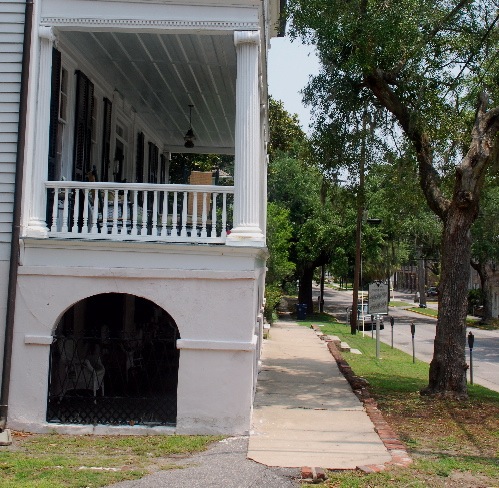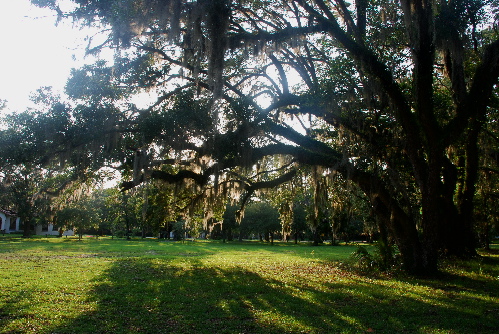Today is the close of my weekend-long trip with the ASLE conference participants to Helena Island, a large fragment of land just off the coast of South Carolina (south-east USA). I’ve enjoyed this trip to the south, but right now it will also be good to have a break from this country’s huge cars, huge portions of food, permissive gun laws, and America-centric view of the world.
There were 18 of us on this field trip, mainly academics, and apart from two of us, all North American. Here a few of us sit on the front ‘porch’ of our story house on St. Helena island, watching the light fade in the ubiquitous Spanish moss hanging from the tree branches. That’s David Ingram in the foreground, Londoner and author of Green Screen, a volume of ecocritical film theory and criticism.
One day we went on a tour of the sounds. This photo was taken as our boat slid along through the waterways of South Carolina’s low country, the area being so named because of its low lying, tide inundated topography. The grasses grow up to the edge of the forest, and then pines and cabbage palms rise up. The climate here is subtropical, and the air is almost as warm and humid as in the tropics. This area was once inhabited by native Americans who made thatch for their shelters from the wide leaves of the cabbage palm. The Spaniards arrived in the early 1600s, but didn’t stay. Pirates used these bays and estuaries as jumping off points to take Incan and Mayan gold-laden ships as they bobbed up the Gulf Stream later in the century. I can’t imagine English pirates careening their galleon on this shore, while armed native Americans flit through the foliage in the background. While we cruised by the marsh grasses and green woods, John Barth’s novel The Sot Weed Factor kept springing to mind. I know it is set further north, in Virginia, but here I was really experiencing the fertility of the eastern seaboard of North America as it appeared to the adventurous and sometimes murderous European flotsam that came here during the 1600 and 1700s.
My sparse knwledge of American history will have to be excused here… The English got over here. Later the revolutionary war ended with the US shaking off the old country. Then there were Africans brought over by rich whites from West Africa and used as slaves. At one point in the early 1800s there were 800 plantations around these immediate islands (6000 whites and 30 thousand black slaves). With such fertile soil and long hours of sunshine the cotton crops shot up and this in combination with the slave labour made the planters so rich that they could fill their estates full of lavish European silver and crystal and extensive libraries. Knowledge and repression side by side… how vile. Then the abolutionist movement arose and the south wanted to be a separate nation… thus the Civil War. We walked through Beaufort, the town which where the cradle of insurgency was located.
When the Union guys (the north) arrived in town in 1862, three days before all the wealthy planter families had high tailed it down the road in their carriages, leaving the Corinthian columns of their white boarded mansions to the company of the Gullah people, the cultural group of African Americans that had formed in this region.
Notice the big windows in this photo. Climate change is causing sea level rise in the lowcountry – dead cabbage palms could be seen on the shore as a result. Also more intense hurricanes are coming to these parts. And still the air conditioned retirees inside houses like this don’t open the floor to ceiling windows on their ‘porches’ to let in the breeze, as they were designed to do a couple of hundred years ago.

We went to a church in which the gravestones had been dug up during the civil war and used as operating beds for soldiers (in the hospital temporarily located inside the church). I can’t think of a worse operating table, symbolically speaking. This gravestone has the cabbage palm on it, the state’s emblematic tree. It is a different species, but it looks like the cabbage palm found on Australia’s east coast.
The Spanish moss on the branches of the Live Oak is my abiding memory of the south. I hope the Gullah people keep ownership of as much of this land as they can, farming it for vegetables as their forefathers have for the last few generations.




Hi Tom–just found your blog–nice photos from both ASLE and the Penn Center. Hope you enjoy your time in the North East. I think you also got most of the American history down pretty accurately, which is more than I can say for the average American’s knowledge of history (American or otherwise), and I’m sure I’m as guilty as the next American of my spotty international history.
At any rate, will look forward to following your blog in the future–hope your cash flow holds out so you can make it to Indonesia!
best,
Jennifer Ho